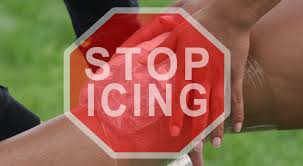Why Icing Your Injury Causes More Damage Than Good

"Why ice?" That is the question that I ask every time I speak with a professional or other elite-level athlete and/or trainer, coach, doctor, or therapist of such an individual who is planning to or considering icing damaged tissue. Most respond with one of the following answers:
Top 3 Reasons People Believe We Use Ice for Injury Treatment
- to prevent inflammation;
- to reduce swelling; or
- to control pain.
 If the above answers seem reasonable and make sense to you, you need to read the following
(now!). If those answers do not seem reasonable and do not make sense to you: congratulations on already being a member of the élite group of informed people on this topic.
If the above answers seem reasonable and make sense to you, you need to read the following
(now!). If those answers do not seem reasonable and do not make sense to you: congratulations on already being a member of the élite group of informed people on this topic.
Why do I say this? Well, since inflammation is phase-one of the life-saving three-phase healing process (e.g. inflammation, repair, and remodel), clearly you would not want to prevent it. But, regardless, icing damaged tissue does not prevent inflammation, it just delays it. Indeed, fortunately for the icers out there, the tissue just rewarms once their meddling is complete and the process resumes.
[box type="note" align="alignleft" ]Many use icing to treat common-place injuries such as swollen ankles, ankle pain, Achilles tendonitis, sciatica, muscle strains, knee problems, shoulders and upper back tweaks and tears.... and all this feeds into the belief of RICE as the best form of treatment. (well it's definitely great for anyone pushing ice packs and gel compresses)[/box]
Icing Damaged Tissue Causes More (not less!) Injury
And, ironically, since icing damaged tissue actually causes more damage, it actually causes more inflammation, not less.
Swelling, or the accumulation of waste at the end of the inflammatory process, is not reduced by icing the damaged tissue. To the contrary, icing damaged tissue actually increases swelling. Indeed, as a matter of simple physiological fact, the only way to reduce the swelling is via the lymphatic system.
And, since the lymphatic system is a passive system nearly fully reliant upon muscle activation around the involved vessels to move the “waste,” icing does nothing but slow (or worse, stop) the process.
 Further, I must make one extra point here: the amount of fluid sent the injury “site” is not an arbitrary or chaotic event. Instead, it is tightly regulated process controlled by your innate intelligence. Thus, “swelling” is not the result of too much fluid being sent to the site but rather the result of too little lymphatic drainage resulting from insufficient muscle activation to ignite the passive lymphatic system.
Further, I must make one extra point here: the amount of fluid sent the injury “site” is not an arbitrary or chaotic event. Instead, it is tightly regulated process controlled by your innate intelligence. Thus, “swelling” is not the result of too much fluid being sent to the site but rather the result of too little lymphatic drainage resulting from insufficient muscle activation to ignite the passive lymphatic system.Icing damaged tissue does, however, sometimes give temporary pain relief. But, it also delays healing, causes damage, increases swelling, and, perhaps most importantly, shuts off the nerve signals that alert you to which movements are harmful to your recovery process. And, since “good movement” is an essential part of the healing process (and bad movement is harmful), you need (and want!) the feedback more than you need (want) a short-term distraction that ultimately makes your problem worse, not better.
Icing Muscles Information: Featuring Kelly Starrett of MobilityWOD
Here's a short video of Gary and Dr. Kelly Starrett discussing icing.
[embed]http://youtu.be/0UmJVgEWZu4[/embed]
To learn more, read my book, “ICED!: The Illusionary Treatment Option- Icing Is Wrong – Learn the Fascinating Story, Scientific Breakdown, Alternative, & How To Lead Others Out Of The Ice Age” and join the meltdown.
[divider]
[caption id="attachment_14560" align="alignleft" width="241"]
 Book: ICED! The Illusionary Treatment Option: Learn the Fascinating Story, Scientific Breakdown, Alternative, & How To Lead Others Out Of The Ice Age[/caption]
Book: ICED! The Illusionary Treatment Option: Learn the Fascinating Story, Scientific Breakdown, Alternative, & How To Lead Others Out Of The Ice Age[/caption]Gary Reinl's snap shot bio:
Author, speaker, teacher, liaison, manager, spokesperson, franchisor, program designer, strategist, researcher, business owner, personal trainer, husband, father, veteran marathon runner, vegan
Click here to own a copy of ICED!




































































































